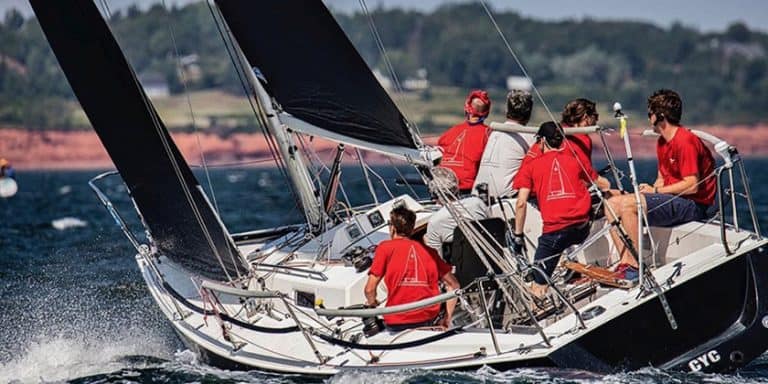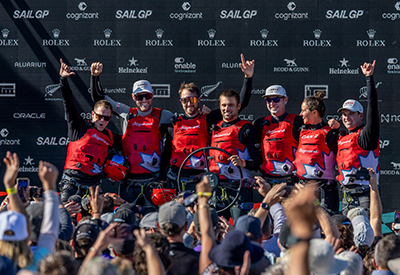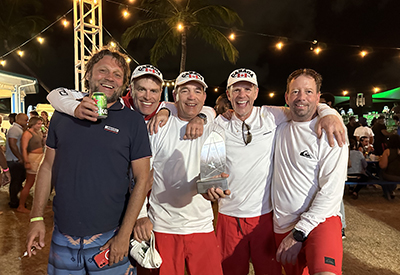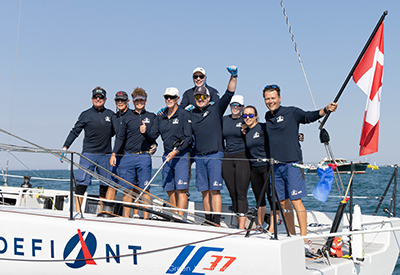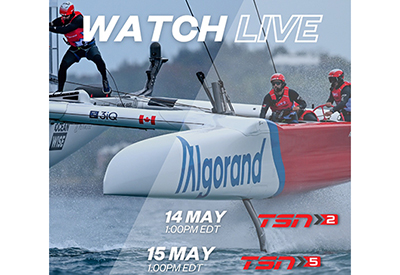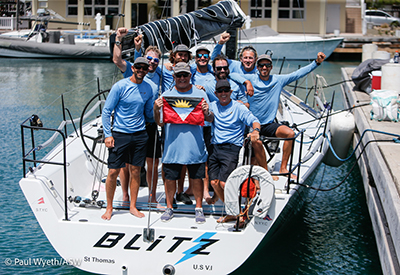Paddy Boyd Joins CYA
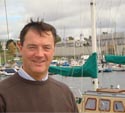
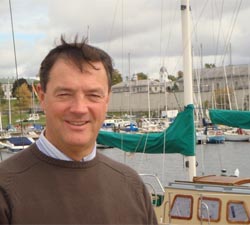
On September 15, after an 18-month global search, the Canadian Yachting Association announced the official appointment of Paddy Boyd as Executive Director. Recently, Canadian Yachting sat down with Boyd at the association’s headquarters in Kingston, ON.
CY: This position involved moving your family from Ireland. What made it worthwhile?
PB: A number of things. One, I had done a similar job in Ireland for some time, as Chief Executive and Training and Development Officer of the Irish Sailing Federation, so I understood the requirements. Two, the challenge was a good challenge. Three, there’s a bit of excitement in taking on new responsibilities in a new country.
CY: Moving a family from one country to another is a major life change…
PB: It is, but we live in a world where change is constant, and if you don’t meet up to the challenges, you fall by the wayside. Still, having served in a similar position made it less of a wrench. It’s also been made a lot easier by global communications. My family can stay in contact with their friends back home, which wouldn’t have been the case 10 or 15 years ago.
CY: Had you been to Canada before?
PB: Yes, many times. In a previous life, I was in the Merchant Navy, and we used to make calls on the Great Lakes and the West Coast. We also have friends and family here.
CY: How similar are the Irish Sailing Federation and the CYA?
PB: The similarities are much greater than the differences. The federation is the national governing body for the sport of sailing and yachting in Ireland, and the CYA fulfills the same role here. But for historical reasons their roles also differ. Every boat now built in Europe has to meet a harmonized construction standard, which was initially brought in as an easing of trade barriers and is now effectively a safety measure. So, the ability of European sailing organizations to influence draft legislation has become a major component of their work.
The CYA is not involved in that role here, but that’s not to say that we shouldn’t be monitoring regulation or potential regulation to see what’s there on behalf of our members. CYA plays a much greater role in sailing and sailing development… Working in a field where people are enjoying a sport and it’s their recreation makes it a lot of fun.
CY: What personal challenges are you looking forward to?
PB: The sheer size of the country is a challenge. The CYA is all about people, and getting to meet and talk to and understand where these people are coming from. Back in Ireland, I could get into my car and within an afternoon I could be with any one of the member clubs. That’s not the case here, and one challenge facing me is to go and interact with the members. It’s helped obviously in this day and age with the ease of communications, but I believe you still have to do the legwork. I want to meet people in their own areas. So that’s an exciting challenge — seeing a new country with all its diversity.
Another challenge is funding. The CYA has worked very hard to progress from a deficit in 2007/08 to a surplus in 2008/09, and we want to maintain this progress… Since our government funding is based on success, we have to develop a system that promotes success. For instance, we want Canadians to do well on the international stage. If our sailors do well, that’s recognized by the government, funding improves, and we can continue investing in the development of the sport. There are so many people in CYA involved in training, coaching and development, and we all want to see it as successful.
CY: So does that make it a collaborative process?
PB: Absolutely. We’re very heavily involved now in long-term athlete development, which has been adopted by all Canadian sports and supported by Sports Canada, so in sailing particularly, virtually from cradle to grave, we look at how we introduce people to the sport, how we give them the fundamentals, how we help them learn how to train, how to compete, how to succeed all the way along. And from that is the lifestyle sailing, which branches off to cruising, ‘beer can’ racing, all those kinds of areas.
CY: What are the implications for the CYA?
PB: This has been in development for a few years now, but because it is quite fundamental it’s important that all the stakeholders buy into it. And the CYA is working very hard on that. It will impact on certain areas, but it’s all very positive and it will mean, for example, that our kids will have age-appropriate and physical-development appropriate training and learning. For instance, kids have growth spurts. All of a sudden they don’t fit into their shoes any more. ‘Why is my child not doing the Optimist event?’ Well, because he or she has suddenly outgrown it. Coaches and instructors are now going to be trained to do this from a sailor-centered point of view, and the actual physical and developmental stage that their young sailors are at. So it is very big. It is a sport-wide, Canada-wide program that has been rolled out.
CY: Given the number of CYA stakeholders, how does the CYA prevent itself from being stretched too thin?
PB: You have to use the structures that are there. It’s the provincial sailing associations that will be delivering the programs at the local level. We’ve got an extensive volunteer network. We’ve got the staff here who have specialist areas. So for me, it’s trying to coordinate all these resources so that we get the message across.
CY: With multiple stakeholders, there’s always a potential for conflict over competing interests. Is this a concern?
PB: Sure, but I think that one of the greatest strengths of any sport is the volunteers, who are involved because they love the sport and want what’s best for it. Now, the ultimate long-term benefit of the sport is going to create conflicts for the short term. And we have to use the powers of persuasion and negotiation to help people understand that what we aim to accomplish, and what we hope they will help us aim to accomplish, is for the long-term benefit of the sport.
CY: And by ‘we’ you’re talking about the CYA and its stakeholders?
PB: Yes, we will be embarking on a planning process that embraces all the stakeholders, so we’ll be going out and talking to everyone involved, right across the country, down to the grassroots level to determine what’s best for the sport and to work out how we’re going to go about that. So, this strategic planning process will lead to an operational plan, which will set out the actions that we have to take to ensure that the sport is for the benefit of everyone in Canada.
Because we have a wide variety of stakeholders and a vast territory to cover, it’s important to get the buy-in of all the stakeholders. This can be quite a long process. You can’t impose a strategic plan on an organization. It has to be developed organically, and we have to go and talk to people about that. The annual general meeting is one opportunity, but we will also visit people in their own areas.
CY: Do you anticipate the next strategic plan to be a significant departure from the most recent plan?
PB: The next strategic plan will determine where we want to be in five to 10 years time, and how we get there is the nuts and bolts of it. I think it’s a changing world. Circumstances have changed considerably since the previous plan, so the nuts and bolts will probably be quite different. I think also that several things will come out of all this — how we govern and operate ourselves, have we got the most efficient and responsible model, how we’re funded, what the balance of reliance on funds should be… At the moment the CYA is quite heavily reliant on government funding.
CY: As someone new to the association, yet who has a lot of experience in this area, what do you see as its strengths?
PB: Oh, the people. Everyone that I’ve come across is very giving of their time. The volunteer board, the volunteers at all levels, the staff, all are dedicated. All are determined to do what’s best for the sport and what’s best for Canada. That’s an enormous strength. Canada also has some of the nicest sailing waters in the world, and a vast amount of water, so access to the water is relatively easy compared to other parts of the world. On the downside of that, access for a large part of the year in the central areas of Canada is restricted. So overall, loads of resources, but people will be the key resource.
CY: What potential opportunities do you see for the CYA?
PB: We have great potential at the high performance level, and we’ve got some great coaches to bring these sailors along. I think that there are also other areas which are less high performance but have potential. For example, in offshore sailing, Canada doesn’t figure that high on the world’s radar, yet there are some Canadians who are working to change that.
Derek Hatfield, for example, who is more recognized overseas than in Canada. There is also potential to get involved with the Volvo Ocean race, particularly as Canada has two ocean seaboards which could be potential stopovers.
I think that the whole offshore sailing area is one in which Canada is punching below its weight, and I think that the number of people actually involved in recreational sailing is probably less than the resources could accommodate.
In the UK, every reservoir and gravel pit has its own active sailing club. And Canada is so blessed with water resources that we don’t think about it. I think this is an opportunity to expand or grow sailing, bring it to people who haven’t experienced it. That’s another challenge for us.
CY: So the greater the exposure, the better it is for everybody — stakeholders, the association, the sailing community itself.
PB: I think that there are all sorts of challenges. One barrier to growth is the plethora of winter sports, and the length of the sailing season… the fact that there are many competing sports is a tough environment for a sport to develop in. In the UK and Ireland there are no winter sports to compete with, and the water is available all year round.
CY: What’s your own sailing experience?
PB: I don’t have a boat at the moment. I left behind two Lasers and an Optimist. Back in Ireland, I sailed on a Sigma 33, a cruiser/racer. It’s British-designed and built, and we would race twice or three times a week, and travel to events as well, such as the Irish and UK championships.
It also can sail under the IRC handicapping system, and I’ve done a fair bit under that. I had a Laser for doing ‘frostbite’ sailing during the wintertime, ‘Sunday afternoon dinghy sailing for old fellas’ is the way that it was, and I did quite a lot of offshore racing, but I came from a dinghy background as well.
CY: Have you had a chance to make any sailing plans here?
PB: We won’t start sailing until next spring. For now, we’re buying into the winter sports system. We bought ice skates yesterday.
Paddy Boyd – A Partial History
Here’s a short list Paddy Boyd’s sailing achievements and affiliations.
Recent Sailing
Sigma 33 Tactician and trimmer on 'White Mischief' Irish Champion, 2000, 2001, 2003, 2004, 2006, 2007, 2008
European and British Champion, 2003
Winter frostbiting in a Laser Dinghy
International Sailing Federation
Member, Youth and Development Committee 2000+
Member, Offshore Committee 2000+
Member, Youth World Championship Sub-Committee 2004+
International Regulations Commission – IMO Working Party
Other Qualifications and Affiliations
Yachtmaster Offshore
Powerboat Instructor
Yachtmaster Examiner
Irish Coastguard Marine Search and Rescue Committee
Irish Coastguard Marine Safety Working Group
European Boating Association – Irish Representative
Commissioners of Irish Lights – Users Consultative Committee
Assistant Team Manager, Irish Sailing Team, 1996 and 2000 Olympic Games
Manager, 1989 Irish Admiral's Cup Team
Member, Royal Irish Yacht Club
Former Council Member, Irish Institute of Master Mariners
2nd Coxswain, Dun Laoghaire Lifeboat
Founder Member and President, Federation of Irish Sports
Member, Irish Sports Council Anti-Doping Panel

